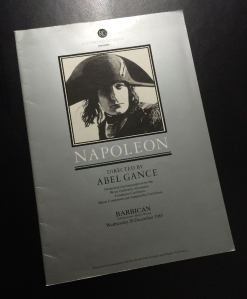
The BFI today announced a new chapter in the remarkable story of Napoleon, Abel Gance’s 1927 silent film chronicling the life and times of France’s most famous Emperor.
This autumn, a new digitally restored version of the movie, completed by film historian Kevin Brownlow and the BFI National Archive, will go on theatrical release in the UK. You’ll also be able to watch it on DVD/Blu-ray, and online through the BFI Player. Best of all, the 5½ hour epic will feature Carl Davis’s remarkable full-length score – the longest ever composed for a silent film.
For true devotees, the icing on the cake will undoubtedly be the premiere screening of this definitive version of Napoleon at the Royal Festival Hall, London, early in November 2016, with the Davis score performed live by the Philharmonia Orchestra.
According to the BFI:
This new version of Napoleon will allow audiences to see the film’s original tinting and toning, including colour combinations which could not be achieved in the existing 35mm print. Integration of sections sourced from a wide range of elements have also been improved by detailed digital image repair and alignment. The film has been entirely re-graded and received extensive digital clean-up throughout, all of which offers significant improvements in overall picture quality. This is the most complete version of the film available, compiled by Academy Award™-winning film-maker, archivist and historian Kevin Brownlow, who spent over 50 years tracking down surviving prints from archives around the world since he first saw a 9.5mm version as a schoolboy in 1954.
 I was lucky enough to attend a live performance of Brownlow’s restored Napoleon at London’s Barbican on December 28, 1983. Running from 3:00pm to 10:30pm, with two intervals and a 90-minute break at 6:15pm, the event was a true movie-going marathon. Carl Davis himself conducted the Wren Orchestra, earning himself and his musicians a truly resounding ovation. Boy, they must have been exhausted when he finally put that baton down.
I was lucky enough to attend a live performance of Brownlow’s restored Napoleon at London’s Barbican on December 28, 1983. Running from 3:00pm to 10:30pm, with two intervals and a 90-minute break at 6:15pm, the event was a true movie-going marathon. Carl Davis himself conducted the Wren Orchestra, earning himself and his musicians a truly resounding ovation. Boy, they must have been exhausted when he finally put that baton down.
An eye-popping three-screen setup allowed for the re-creation – at certain critical points in the narrative – of Gance’s original multi-screen concept – which he called “Polyvision”. According to Gance, “The theme, the story one is telling, is on the central screen. The story is prose, and the wings, the side screens, are poetry. That is what I call cinema. I must admit that from the first moment I saw Polyvision, the normal cinema had no further interest to me. I was convinced that Polyvision would be the cinema’s new language.”
As presented at the Barbican, the Polyvision arrangement saw battles playing out as a series of dizzying multiple images, which periodically came together as one, with the trio of projectors combining to throw a single ultra-wide panorama across the entire triptych. Particularly memorable was the moment when the three screens were tinted red, white and blue respectively, in honour of the French tricolour flag. Film as national identity. Stirring stuff.
Then there’s Gance’s camerawork. In the programme from that 1983 performance, Kevin Brownlow writes, “[In 1927] technicians in the German studios were putting the camera on wheels. Gance put it on wings. He strapped it to the back of a horse … he suspended it on overhead wires … he mounted it on a huge pendulum.” If you find yourself gasping at the sweeping camera moves in the latest Hollywood blockbuster, just remember – Gance got there first.
Unfortunately for Gance, no sooner had his silent epic Napoleon hit the screens than the talkies arrived, in the form of The Jazz Singer. His film fell into obscurity, and it’s only thanks to decades of diligent detective work by Brownlow, and the support of the BFI, that we have something approaching the director’s original vision today.
I don’t know if my ageing bones are up to another Napoleon marathon when this new digital restoration shows up later in the year. On the other hand, my memories of that 1983 performance are so fond, and so powerful, that it’s hard to imagine not seeing the film in its true colours.
All three of them.
For a quick taste of the Napoleon experience, check out this trailer for the restored epic’s US premiere at the San Francisco Silent Film Festival in 2011:
